Table of contents
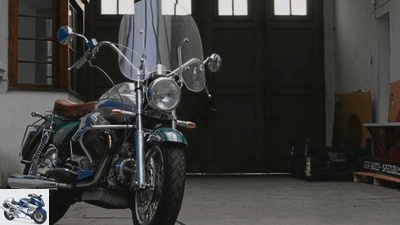
Fred Siemer
Sports & scene
Scene: Moto Guzzi Baker
Scene: Moto Guzzi Baker
The workshop of the Guzzi specialist
Content of
Anyone who trades with Moto Guzzi should also be able to trade with tradition. With his workshop and his conversions, Reinhard Backer gives this commandment an impressive form.
Fred Siemer
02/25/2011
Of course, it helped that he belongs to the small group of dealers who do business on nothing but Moto Guzzi put. Nevertheless, it must be mentioned at the beginning of this story that Reinhard Backer was honored as the world’s best Guzzi dealer after 2007. Really with a trophy, presented by important Piaggio board members.
In normal life he acts like the optical counterpart to an Italian motorcycle manager, and he does not reside in a dazzling metropolis or on a glorious racetrack. But in the tranquil Laer. Munsterland – flat, wide, poor in people. And so down-to-earth that even BMW salespeople need their imagination. Those who survive here with an exotic brand have already proven that they understand their spirit and customers. Whoever achieves more can do more – the award givers have understood.
Moto Guzzi was never glossy; the pilgrims in front of the nostalgic parent plant in Mandello have been singing this song for decades. Guzzi stands for archaic machines and honest sportsmanship. At least according to the historiography that is valid today, which starts with the V2 models and excludes the fact that under the label of the gliding golden eagle there were once large numbers of small cattle and made Guzzi one of the greats of Italy, and at times even of Europe. Forgot, over.
Reinhard Backer also automatically links his brand with V2. A nice Falcone is standing around somewhere with him. This massive single cylinder is based on the earliest works of the motorcycle factory founded in 1921. A 250cc two-stroke in-line twin is parked not far away, an expression of the unfortunate epoch when the industrialist de Tomaso Guzzi and Benelli led the way and made people feel insecure with parallel models. Otherwise, however, the pure doctrine prevails in the bulging exhibition rooms: V2, regardless of whether it is brand new, used or converted.
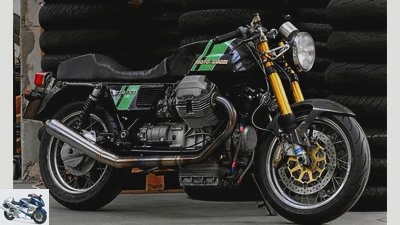
Siemer
For a demanding frequent driver, this conversion is based on S3. The enlarged to 1150 cm³ and 98 HP strong V2 (bohung x stroke: 95 x 81.2 mm) supply open 41 Keihin flat slide carburetors, fires an electronic Moto Witt ignition system and disposes of a VA system with 48 manifolds. Four-piston brakes and 320 mm brake discs from Brembo, operated with the help of a radial brake pump, catch everything again. The 17-inch Morad spoked wheels have 120 or 150 mm tires, the Ohlins upside-down fork is in converted Guzzi V11 triple trees.
From fan to racing driver to dealer – the career of Reinhard Backer from Munster followed this pattern. But tuned by a business school diploma and a degree in object design, he knew how to avoid the often tragic end of this path. One after the other: When he was less than 20 years old, he got a new 750 in 1976 S3 and experienced his very own Guzzi enlightenment.
So stable the chassis, so good the brakes that the buddies usually disappeared from the rearview mirror after three or four turns. The great feeling turned into courage, Backer started in Zuvi races. Because the parents’ garden pavilion was also suitable as a workshop, profound improvements were due, because the series sport hardly allowed them, the new BoT racing appealed. In the Battle of Twins, the young Studiosus fought courageously and at times even with the support of renowned Guzzi dealers.
As an active athlete, Backer not only got many parts a little cheaper from the then importer Motobecane in Bielefeld, but was also allowed to take part in mechanic training. Not a bad basis for repairing or rebuilding something for this or that friend.
When traveling to Italy there was a lot of shopping and the number of friends increased. Gradually the idea of owning a shop matured – and in 1994 it became a reality made of bricks. The old weaving mill in Laer was looking for new users, and Reinhard Backer officially set up his own business with a four-point business idea. He wanted to trade in used vehicles that he gave a guarantee. He only wanted to fix Guzzis. His BoT experience should flow into healthy engine and chassis tuning. After all, he wanted to create TuV-compatible special conversions.
The sale of new motorcycles and spare parts has been enriching the business for twelve years, but before that, baker had to cut a big hole in the old weaving mill: no matter how hidden it is – without a shop window he would never have got a dealership agreement. Since then, the good Laerer have been able to marvel at a Cali or Griso when they walk the dog in the evening.
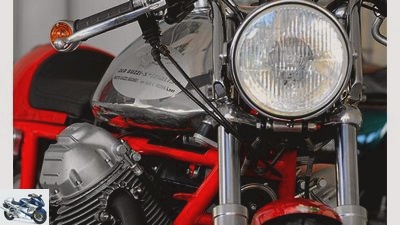
Siemer
The aluminum tank and one-man GRP hump nestle on the coated frame of the Transconti. From a displacement of 948 cm³ the engine gets 85 HP and at 5000 rpm a whopping 95 Nm. Open 40s Dell‘Orto carburetors, polished ducts, re-ground camshaft, Lafranconi Competizione system and a simplified clutch make it work. The dry weight is 185 kilograms. 2.15 and 3.00 inch wide 18-inch Akront high-shoulder rims as well as air-assisted Fournales struts and a revised standard fork carry the whole thing. Price: from 19,500 euros, including a one-year guarantee.
But back to Baker’s basic idea. It is based on the classic values of many V2 Guzzi. One V7 Sport, an S3, a Le Mans I or a T3 California are icons of the boom years. Everyone who has one wants to keep it, everyone who was only allowed to dream back then wants one today. The later Le Mans and California are now almost as popular, and the classic tourers from V7 to 850 T to 1000 SP also have their fans.
All these youngtimers are united by their robust substance, which is why there are several thousand scrap iron among almost 40,000 Guzzis registered in Germany. The current registration statistics, for example, have 2500 Le Mans I to III – more than remarkable for a sporty and correspondingly demanded motorcycle. Of course, the many identical parts of the large V2, their long model cycles and the relatively safe supply of spare parts to this day help to secure the inventory. Even those who restore a treasure from the 1970s will never suffer the pain that most Nippon fans struggle with. Just call people like Reinhard Backer and order parts.
Or have it restored: At the moment, Backer is working with his two mechanics and the apprentice on two Calis, one with 230,000, the other 270,000 on the clock. Everything is dismantled and measured and bead-blasted, of course. Then a lot of new parts are due, from the valve train to the pistons to the bearings of the transmission shafts. The benches will be re-upholstered, frames will be coated, and suspension struts will be replaced. The paintwork has to be renewed and certainly not all indicators are okay anymore. But none of these works requires delicate improvisation, nowhere do the parts run out. In the end, there is a price on the one hand like a brand new upper-class machine, but on the other a stable-value classic with high everyday talents.
The Guzzi construction kit allows great freedom. Backer has already built a cruiser out of a Le Mans IV that is more than worth seeing. Within the Harley-dominated clique of its owner, this Guzzi really goes its own way, sounds fuller than most thanks to open Lafranconis and brakes much better than all Milwaukee irons thanks to double Brembo four-piston calipers. A 1100 fuel injector provides propulsion that is befitting, WP legs use the sparse travel of the rear suspension as best they can.
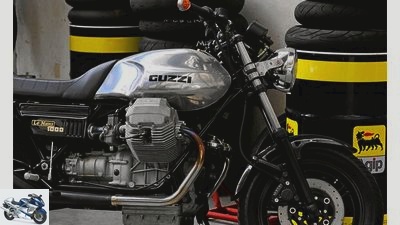
Siemer
Above: Some call it an all-rounder, others call it a driving machine: The completely measured and rebuilt 850 series has a camshaft that has been reground for more torque. It tolerates unleaded fuel and breathes through open series carburettors. Its exhaust gas is disposed of by open Lafranconis, the output is 67 hp. A Le Mans bench is attached to the aluminum tank. Left: In the original, the clutch, including the flywheel, weighs over seven kilograms. This guarantees a stable and low idle, but hinders fast revving and good shiftability of the transmission. This coupling from Guzzi-Backer, lightened by a good three kilograms, achieves a successful compromise.
An old Guzzi can do a lot, just not comfort. This is prevented by the limited flexion angle of your cardan universal joint. With the California and the tourers, well-shaped seating furniture compensates for this deficiency, with the athletes it does not really matter. Nevertheless, even tough country road heroes are happy about beautifully appealing spring goods. Many series forks are being revised in this regard, but triple clamps to accommodate Ohlins elements are also available.
For sporty roadsters or hearty country road athletes, Reinhard Backer’s heart beats particularly hard, because this is the segment in which the Guzzis can fully exploit their potential. Even the older engine with rounded cylinders and heads can easily be tuned as an 850 to over 70 hp without becoming bitchy or unreliable. With a 948 cm³ set at least ten extra horses trot, and whoever implants the angular 1100, ends up with 90 to a good 100 hp. Depending on the equipment, the weight is between 200 and 220 kilograms with a full tank – so even the paper form promises happy gasping. And registered in the vehicle documents for frames built up to 1989 are often 103 decibels of driving noise, caused by open carburettors and equally revealing exhaust systems. Where traffic density and regulations inevitably lead to deceleration, such an overall arrangement certainly promises more enjoyment than current 180-horsepower cars.
Reinhard Backer sees himself as an advisor for his special structures. Sometimes he talks someone out of an expensive double ignition because the last three horsepower doesn’t matter, sometimes he shows what is optically possible. The customer ultimately decides within what is technically and legally possible, but there are no concessions in one respect: When it comes to function, the same standards apply as for a new motorcycle.
That has its price, but bakers simply don’t feel like making a mess. And can live with it: Guzzis modified or restored by him are what Le Mans or California always have been – dreams that unfortunately not everyone can afford.
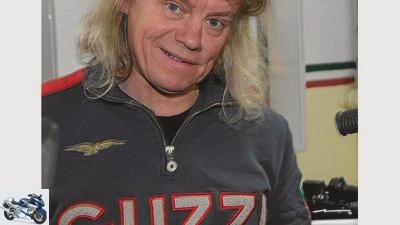
Siemer
Guzzisti through and through: Reinhard Backer, Am Bult 4, 48366 Laer, www.motoguzzi-baecker.de.
What are the typical weak points of the large Guzzi two-valve V2?
In terms of substance, none. A number of machines run well over 100,000 kilometers before the first overhaul, and many can manage over 200,000 without major interventions. However, we’re talking about motorcycles that are up to 40 years old; Especially the Bosch alternator, regulator and diode plates require a keen eye. The Limas of later models fit, however. In models used for sporting purposes, the exhaust valves tend to leak after a mileage of 75,000 km. The cleanly designed five-speed gearbox causes few problems. At most, we notice pitting on a fifth gear wheel. The next “weak point” is actually a plus point: the crank pin of the crankshaft houses a small oil reservoir in a groove. Suspended particles also settle there over the course of many years, which compress graphite-like and can migrate into the oil channels. In order to clean the groove, a stopper secured with grit must be unscrewed – no beginner’s exercise. Finally, the threads of the filler openings of the gearbox and final drive: If those with heavy motor skills attach the M10 screws used there incorrectly after every oil check, these threads suffer.
And what about the chassis?
The frame is basically very solid. You only have to be careful if the motorcycle has been in a trailer for a long time. As is well known, the Guzzi fork carries damper cartridges, which – just like the struts – have to be replaced after a certain age. The replacement installed by us speaks better than the original parts or the mostly inadequate accessory damper inserts. I recommend Ikon as a proper replacement shock absorber. There are springs of different hardness, so they can be easily adapted to the profile of the machine. Sports-oriented customers prefer shock absorbers from Wilbers or Ohlins because they respond even better. We also use forks from the Guzzi V11 or Ohlins. However, you have to know that such a precious part usually has to be resealed after four years.
The Guzzi electrics didn’t have a good reputation. Your assessment?
Okay, those huge old batteries all ate something. Then the power stays off because a thick cauliflower has formed at the ground pole. Today we are mostly in trouble because there was so much tinkering in the past. It is teeming with cheap plugs and other improvisations. Fortunately, the wiring harness is still available as a spare part. Actually, even the often ridiculed old switches are okay. I think the old ignition system with its two breakers is better than other contact-controlled systems of their time. But today customers want electronic ignition. We have had very good experiences with the DMC2 from Moto Witt, to which we can convert all contact-controlled motors. The first electronic systems installed by Guzzi from the 1000 S and California III were not good.
What increases in performance are possible?
So far, when we restore or convert a 750, we’ve always installed the 850’s crankshaft. The longer stroke simply brings a lot more elasticity. So, and because new pistons and cylinders often have to be added during a restoration, I recommend a very good conversion kit with an 88 bore for all 850 engines. With a series stroke of 78 mm, this results in a displacement of 948 cm³. This does not increase the power yet, but it reaches its nominal value and is applied earlier. The torque increases by a good ten percent. My Transconti has this engine, and I brought it to 85 hp with very conventional tuning. With more effort – including flat slide carburetors – the 1100 engine can last for a good 100 hp and is suitable for everyday use. With a double ignition you can get a few more horsepower out with optimal peripherals, but I now consider the effort to be excessive. California and touring enthusiasts who don’t want speed beyond 150 km / h often choose a camshaft that has been reground for more torque.
The open carburetors do not cause any problems?
No, I can say that after decades of experience. Even all-weather and touring riders don’t have to worry about it, and because of the noise there weren’t any problems until 1989, when the frame was built. In addition, the accessibility of many parts increases when the air filter box is omitted. But hands off cheap funnels with flywire. This coarse wire reduces the intake cross-section to such an extent that you lose up to eight horsepower. If there is wire, then – as with the Dell‘Orto plastic funnels – it has to be arched high. We use funnels that are completely open and milled from solid.
Lafranconi exhaust systems don’t seem to be standard with you. why?
They look great and are simply part of the line on certain motorcycles. But in terms of processing, our VA system made in Germany is better. In their day, the Guzzis always had good brakes. And by today’s standards? They are still good with our accessory rubbers. Of course, it gets even better with modern discs and four-piston calipers from Brembo, which can be easily adapted. I almost always recommend not deactivating the integral braking system, because it really has advantages in normal road traffic.
Why do you replace the standard starter with some modifications?
Because the old Bosch starter is not geared down and therefore requires a huge battery. For this reason, lighter Valeo starters were temporarily used for sporty conversions, now we’re using a new one from Bosch, both with reduction. Instead of 30, a full eight ampere hours are sufficient for this, but from a powerful gel battery.
What is the trend for Guzzi conversions and restorations??
For around ten years now, many customers have been asking for sporty roadsters for conversions. But recently we have been registering the desire for a structure that is as classic as possible and oriented towards the original. In my opinion, the California will soon become even more popular, simply because there are now too many Harleys. And in the medium term, too, I assume there will be strong interest in the tourers, because of all the people who prefer versatile motorcycles today, some of them would like to ride a nice, versatile motorcycle at some point.
Related articles
-
Restoration of Moto Guzzi Le Mans I and Moto Guzzi V7 Sport
Siemer 24 pictures Siemer 1/24 Two Le Mans I and a V7 Sport in original and museum condition. Siemer 2/24 Reinhard Backer doing the freestyle. Freehand….
-
Moto Guzzi Classics in California
Blacksmith 19th pictures Blacksmith 1/19 Old-school Guzzi screwdriver Mark Etheridge. Blacksmith 2/19 One last look at the hodgepodge, then ……
-
counselor workshop 75 years of Moto Guzzi 75 years of Moto Guzzi The emperor’s new eagle 30,000 Moto Guzzi fans witnessed the rebirth of a motorcycle…
-
ZepGori 17th pictures Michael Orth 1/17 Machine 11: based on Le Mans 3, 950 cm3, 82 hp, weight 184 kg. Michael Orth 2/17 Finished conversions are…
-
archive 36 pictures archive 1/36 Buying advice: What to look for when buying a large-displacement Moto Guzzi twin from the 70s and 80s. archive 2/36…
-
Driving report Moto Guzzi V7: More relaxed with thicker cheeks
News 2022 New motorcycle items for 2022 Moto Guzzi 32 pictures Moto Guzzi 1/32 Moto Guzzi is significantly up-dating the V7. The 850 twin from the V9 and…
-
Moto Guzzi V11 range tips for buying used
Rossen Gargolov 13th pictures r-photography.info 1/13 Moto Guzzi V11. r-photography.info 2/13 A feast for the eyes: classic Le Mans watch ensemble….
-
Gargolov 14th pictures Gargolov 1/14 Harley-Davidson 1200 Custom, Kawasaki W 800, Moto Guzzi Bellagio, Triumph Scrambler: With these four classic bikes,…
-
Moto Guzzi in the 2020 model year
Moto Guzzi. 15th pictures Moto Guzzi. 1/15 Moto Guzzi V85 TT. Price: from 11,990 euros. Moto Guzzi. 2/15 Moto Guzzi V85 TT Travel. Price: from 13,490…
-
Moto Guzzi turns 100: Adler von Mandello celebrates its anniversary
Moto Guzzi 16 pictures Moto Guzzi 1/16 Moto Guzzi is celebrating its 100th birthday and is launching special Centenario models. Moto Guzzi 2/16 A satined…